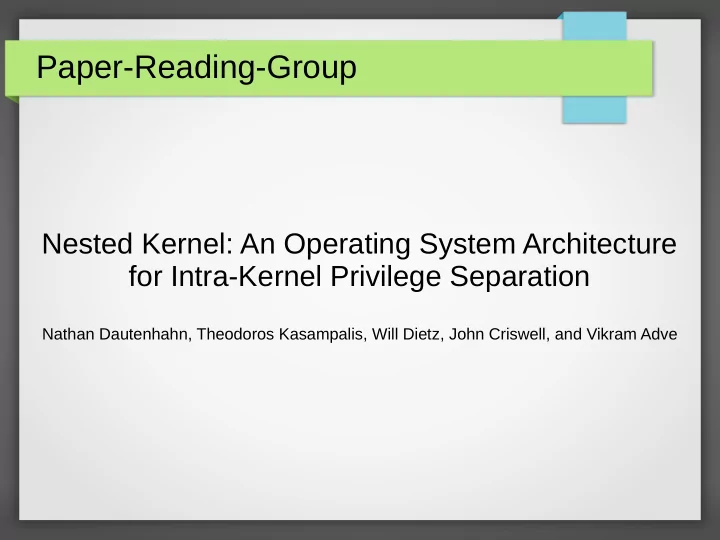

Paper-Reading-Group Nested Kernel: An Operating System Architecture for Intra-Kernel Privilege Separation Nathan Dautenhahn, Theodoros Kasampalis, Will Dietz, John Criswell, and Vikram Adve
Nested Kernel - Motivation ● Monoliths have single large TCB ● How to seperate into multiple protection domains? – Microkernels require complete redesign of kernel – VMMs have high performance overhead How can we provide protection domains without the overhead using the existing code base and design principles?
Nested Kernel - Idea ● Use the MMU to isolate the MMU – Nested Kernel is small and protects MMU structures – Outer Kernel is de-priviledged and only has checked access to MMU structures ● Keep the monolithic address space ● While still enabling application of intra-kernel security policies – Example policies: write logging, write-mediation
Nested Kernel - Design ● Separate policy from mechanism (MMU) ● OS Co-design for security policies ● MMU based privilege separation ● Fine grained resource control ● Negligible performance impact
Nested Kernel - Invariants Invariant 1: Active virtual-to-physical mappings for protected data are configured read-only while the outer kernel executes. Invariant 2: Write-protection permissions in active virtual-to-physical mappings are enforced while the outer kernel executes.
Nested Kernel – write protection
PerspicuOS – Thread Model ● Outer kernel may be under complete attacker control – Can attempt to arbitrarily modify CPU state – Can modify outer kernel source code – Can modify control flow ● Nested kernel source code and binary are trusted – Including the mediation functions ● Hardware is free of vulnerabilities ● Do not protect against hardware attacks
PerspicuOS – Architecture
PerspicuOS – Invariant 1 Support Reminder: Invariant 1: Active virtual-to-physical mappings for protected data are configured read-only while the outer kernel executes. Invariant 3: Ensure that there are no unvalidated mappings prior to outer kernel execution Invariant 4: Only declared PTPs are used in mappings Invariant 5: All mappings to PTPs are marked read-only Invariant 6: CR3 is only loaded with a pre-declared top-level PTP.
PerspicuOS – Invariant 1 Support Reminder: Invariant 2: Write-protection permissions in active virtual-to-physical mappings are enforced while the outer kernel executes Invariant 7: The WP and PG flags in CR0 are set prior to any outer kernel execution Invariant 8: The WP-bit in CR0 is never disabled by outer kernel code Invariant 9: Disabling the PG-bit directs control flow to the nested kernel Invariant 10: The nested kernel controls the SMM interrupt handler and operation Invariant 11: Enable the WP-bit on interrupts and traps prior to calling outer kernel interrupt/trap handlers Invariant 12 : Enable the WP-bit on interrupts and traps prior to calling outer kernel interrupt/trap handlers Invariant 13: The nested kernel stack is write-protected from outer kernel modifications
PerspicuOS – Entry & Exit
PerspicuOS - Evaluation Example Mediation Functions: ● Write-only data ● Append-only data ● Write logging
PerspicuOS – Evaluation (2)
PerspicuOS – Evaluation (3)
PerspicuOS – Evaluation (4)
Conclusion ● Nested kernel architecture ● Using the MMU to protect the MMU ● Write mediation policies for memory ● Protection domains without using VMM/Processes ● Based on addresses
Discussion Pro: ● Great if you want to log write accesses ● If the intention is rootkit detection this might be nice Con: ● Not really suited for isolation of components ● Can't you still attack e.g. communication? ● The overhead evaluation … sucks
Recommend
More recommend